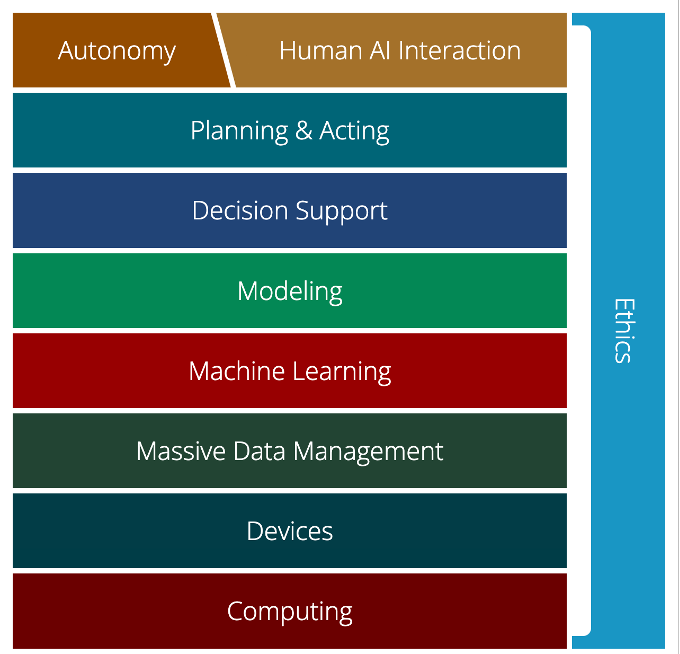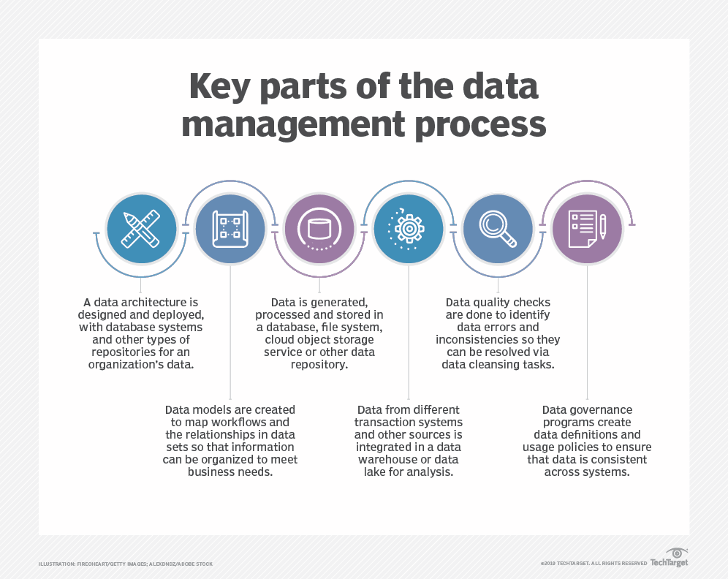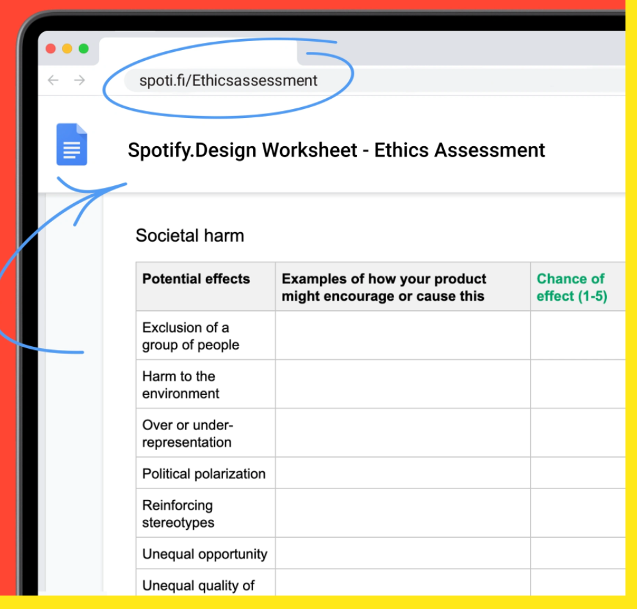What it means for the arts and how to implement it today
Introduction
As I quickly approach my graduation from one of Carnegie Mellon University’s data analytics programs, I’m encouraged to reflect on the key lessons I will take into the work force. One consistent lesson is what it takes to incorporate Artificial Intelligence (AI) into an organization: Carnegie Mellon University (CMU) was ranked number one in 2022 for Artificial Intelligence Programs by U.S. News and World Report. Incorporating CMU’s AI lessons is critical for all industries but particularly those that are historically considered to be “non-technical fields.” Within these fields, the ones who thrive will be those who incorporate at least the lower levels of the stack, namely data management, but an understanding of each layer of the stack will provide industries with a road map to understand how they can increase the efficiency and output of their organization’s business processes.
Explanation of AI Stack
As technology becomes an increasingly large part of the workplace, organizations are encouraged to engage in “full stack” operations. At its heart, this means that organizations should work through developing each level as shown below:

While there are MANY definitions and paths to achieving artificial intelligence within an organization, Carnegie Mellon defines AI as understanding human needs and making “…smart decisions based on that understanding.” Each of the levels in the diagram is achieved through iterative developments. Below is a brief definition of each layer of the stack and key considerations for the arts to consider within each.
Computing & Devices
Defined as “…the collection of computer machinery, data storage devices, and networks that support the processing and exchange of electronic information,” the computing environment is likely the electronics within an organization that everyone will interact with and touch. If computers are too slow, data is strictly stored in old servers, etc, this can cause a shaky foundation for the rest of the stack. MIT defines three areas that make computing and devices different with AI in mind:
- Carry out calculations in parallel – “speed” historically is how fast a computer could perform a single task (for example, loading a web browser). But now, computers are expected to load a web browser in the foreground while updating a database in the background. Talking to the organization’s IT team about the capabilities of devices (particularly in terms of parallelization) is important in determining the technology expansion capabilities of the organization.


2. “Learning” rather than listening – Historically, computers took a single input from users and executed a task. When we think about devices in the context of the AI stack, however, devices are now expected to learn. In personal devices, this takes the form of voice recognition (Siri) and image recognition (unlocking an iPhone using facial recognition). The application of this in the art world is a greater application to recognize images and sounds. For example, with the proper devices and computing capabilities, museums can implement technology such as determining if a piece of artwork is a fake work or not.

3. Computerization of the commonplace – Think of this aspect of computing and devices in terms of a “smart house.” Modern infrastructures (i.e. storage of data on the cloud) enables things as simple as a doorbell to expand their capabilities to become “smart” technology. If smart technology has a place within an industry, it’s important to first identify if the computing and devices infrastructure can support this change.
Data Management
Data Management is critical to business success. Higher level processing and productivity within an organization cannot happen without proper data management, so in many ways, data management is the most critical level of the AI stack. Data management is defined as “… the practice of collecting, keeping, and using data securely, efficiently, and cost-effectively.”The path to proper data management for different organizations can take many forms, but below is an example process for establishing data management:

The key to data management ultimately comes down to one word:
VALUE
Data management has shown to bring organizations increased value by streamlining process and revealing where to focus business strategy. In the art industry, this could mean greater customer analytics within an art museum to see which populations visit most often, and therefore which populations to target with promotions and deals. For example, if detailed data management and analytics reveals that families with kids between the ages of 2 and 12 make up the majority of museum visitors over the summer, the museum could focus its displays and programs during those months on catering to that population.
Beyond the art industry, civic organizations and local governments have already shown how much value proper data management can generate: by creating the infrastructure for open source data management, the public sector “… has sparked innovation, driven efficiency, and fueled economic development.” Imagine the possibilities for the art industry if more art organizations do the same.
Machine Learning and Modeling
Machine Learning (ML) is an over-used and often misunderstood term. ML is defined as “…the systematic study of algorithms and systems that improve their knowledge or performance with experience” (Akoglu). In plain terms, ML and modeling are advanced math applied to data using computers. The most promising applications for ML in the art industry currently are the automation of business processes (see below), but there are also many examples for how ML is being used to GENERATE art. For more information on this, check out this Ted Talk on music and art generation using machine learning:
Decision Support, Planning, & Acting
This portion of the stack refers to systems that have surpassed the functionality of modern machine learning. The decision support layer simply “helps humans make decisions,” while the planning and acting layer “…rely on optimization, safety, the knowledge network, and strategic reasoning” to learn from information they are given. It’s difficult to understand why and how this layer is different from ML and AI (or why it fits in between the two layers in CMU’s AI stack), but this layer teaches us that the level of task automation and computer “learning” exists on a spectrum.
Autonomy / Human AI Interaction
Human AI interaction is defined as “… the completion of a user’s task with the help of AI support.” While AI can often be an intimidating concept and mistrusted by those who are unfamiliar with it, it has many potential applications within the art industry for automating production, identifying and maintaining consumer markets, and other task completion and automation.
Ethics
A discussion of the AI stack would be incomplete without stressing the importance of ethics in AI development decisions. Beginning with the data management layer, the art industry has the potential to store and track large amounts of personal data on its customers (similar to other consumer industries). The art industry is largely trusted by its consumers, so as its capabilities within the stack expand, ethical design is critical. Large companies within the art industry have identified its necessity and have started to build infrastructure around ethical decision making which can provide a guide for other smaller organizations. For example, Spotify created an Ethics Guild to make ethical considerations “more concrete.” They created a simple Google document open for other organizations to use that evaluates the decisions within the AI and technology stack that different groups within an organization are making as shown below:

How to Bring ‘the Stack’ to the Arts
1. Increase data literacy
Data literacy is defined as the collection, examination, analysis, and interpretation of data to inform a decision. Using data to inform decisions is one of the most important first steps an organization must take before considering any higher parts of the stack. Organizations can do this by heavily democratizing data (ensuring all members of the organization have access to it) and increasing ease of use whenever possible.
To be clear, data democratization is not synonymous with data anarchy; not every member of the organization should have access to all the data. For example, the managerial and janitorial staff of a concert hall may not need access to detailed demographic data on the concert hall’s visitors and guests. However, it would be very useful for them to have visitor frequency data (what times of the year or what types of shows bring in the most visitors) so that they can plan accordingly for peak bust times.
2. Use art itself
In 2016, an education study was conducted in Brazil that looked at how to increase data literacy in young children. After testing different methods, the research team found that those students who learn using visual arts activities performed far better in tests than those who learned through traditional educational methods. The take-away? When looking at how to bring data literacy and eventually the stack to arts workplaces, use art! It’s proven that people respond best learning a new concept through creative methods.
One of the researchers, Catherine D’Ignazio, identified tactics that could help to build data literacy[2] that included building learner-centric tools and favoring creativity over purity. Teaching technical concepts doesn’t require intensely ‘academic’ verbiage or techniques.
Data literacy is intimately intertwined with increased use of visualizations to communicate results. To generate change within an organization or inspire people to action, visualizations are often the best way to captivate an audience. Consider the visualizations below:

Although beautiful in its colors and layout, the visualization has a specific purpose: to educate people on ways child mortality has been reduced historically. Visualizations appeal to a wide range of emotions (similar to art), and often provide information to viewers that would be lost in traditional reports. For example, if you are a manager for a music production company, creating visualizations that show declining sales in the form of a descending scale on a piece of sheet music, this could grab the attention of the audience more because it is shown in a familiar medium. The visualization options are vast, and the benefits of incorporating art into data management strategies are endless.
3. Automate when possible
During the pandemic, 42% of art organizations had to decrease the number of people on their staff, but 65% were still delivering some sort of content. The arts industry must adopt some form of technology for administrative tasks and distribution in order to stay afloat in an increasingly digital world.
Business automation tasks include the following:
- Responding to emails – when it comes to customer feedback, develop a system to automatically sort and respond to any correspondence an organization receives
- Data management functionalities – depending on the data collection and storage methods used by an organization, data “pulls” and back-ups can be easily automated using out-of-the-box software systems
- Customer engagement – social media posts, emails, and other promotions can be setup on a time schedule so that employee time is not taken up by maintaining a customer engagement schedule
There is a plethora of task automation tools available on the internet, and it is important to develop time to determining the best fit between software systems and the organization.
Conclusion
“I say, run toward the data. Take your data back and turn it into something meaningful.”
Laurie Frick, From Paint to Pixels
The utility of the AI stack is evident: the organizations that choose to implement it will succeed, while those who fail to implement will likely cease to exist. Although it seems overwhelming to implement the stack within the art industry, organizations can start simply by focusing on the data. Strive towards data literacy and education. It may be the decision that saves the arts.
References:
“7 Steps to Foster a Data-Driven Culture for Your Organization.” (February 18, 2021). Unscrambl. Retrieved March 8, 2022 from https://unscrambl.com/blog/7-steps-to-foster-a-data-driven-culture-for-your-organization/
Akoglu, Leman. “Lecture 1: Machine Learning: Basic Concepts.” (Spring 2019). Course Notes for 95828: Machine Learning for Problem Solving.
“AI Stack” (2022). Carnegie Mellon University. Retrieved May 3, 2022 from https://ai.cs.cmu.edu/about
Baker, Melissa (Dec 27, 2019). How to Create a Technology Adoption Strategy that Works. Burwood Group. Retrieved March 8, 2022 from https://www.burwood.com/blog-archive/technology-adoption-strategy
Batti, Khadim (Feb 6, 2020). How Technology Could Impact the Workplace Over the Next Decade. Forbes. Retrieved March 8, 2022 from https://www.forbes.com/sites/forbestechcouncil/2020/02/06/how-technology-could-impact-the-workplace-over-the-next-decade/?sh=620396fb3bd2
Berkel, Niels van, Mikael Skov, and Jesper Kjeldskov (Nov-Dec 2021). “Human-AI Interaction: Intermittent, Continuous, and Proactive.” Interactions. Retrieved May 4, 2022 from https://interactions.acm.org/archive/view/november-december-2021/human-ai-interaction
“Best Artificial Intelligence Programs” (2022). U.S. News & World Report. Retrieved April 26, 2022 from https://www.usnews.com/best-graduate-schools/top-science-schools/artificial-intelligence-rankings
Bhargava, Rahul, Ricardo Kadouaki, Emily Bhargava, Guilherme Castro, and Catherine D’Ignazio. (Oct 22, 2016). Data Murals: Using the Arts to Build Data Literacy. The Journal of Community Informatics. Vol. 12, No 3. Retrieved March 8, 2022 from https://openjournals.uwaterloo.ca/index.php/JoCI/article/view/3285
Chambers, Rick (April 27, 2021). Data Democratization just sounds too buzzy. Medium. Retrieved May 4, 2022 from https://2rickchambers.medium.com/data-democratization-just-sounds-too-buzzy-b6e98f001909
Goldstein, Brett and Lauren Dyson (2013) Beyond Transparency: Open Data and the Future of Civic Innovation. Published by America Press, San Francisco. Retrieved March 8, 2022 from https://beyondtransparency.org/
Gummer, Edith S. and Ellen B Mandinach (April 1, 2015). Building a Conceptual Framework for Data Literacy. Teachers College Record. Vol 117, Issue 4. Retrieved March 8, 2022 from https://journals.sagepub.com/doi/abs/10.1177/016146811511700401
Kefford, Matt (Sept 9, 2021). How Can Technology Save the Arts? Business Because. Retrieved March 8, 2022 from https://www.businessbecause.com/news/insights/7813/technology-arts-after-covid
Han, Lu, Eric Madar, and Sara Aboulafia (Sept 2020). “Investigating Consequences with Our Ethics Assessment.” Spotify. Retrieved May 4, 2022 from https://spotify.design/article/investigating-consequences-with-our-ethics-assessment
Haven, Will Douglas (October 22, 2021). “How AI is reinventing what computers are.” MIT Technology Review. Retreived May 3, 2022 from https://www.technologyreview.com/2021/10/22/1037179/ai-reinventing-computers/
Maycotte, H.O. (Oct. 28, 2014). Data Literacy – What it is and Why None of Us Have It. Forbes. Retrieved March 8, 2022 from https://www.forbes.com/sites/homaycotte/2014/10/28/data-literacy-what-it-is-and-why-none-of-us-have-it/?sh=4dd5738168bb
Rampton, John (July 27, 2020). “14 Business Tasks That Can Be Automated.” Calendar. Retrieved May 4, 2022 from https://www.calendar.com/blog/14-business-tasks-that-can-be-automated/
Schmidt, Richard F (2013). “Software Architecture.” Science Direct. Retrieved May 3, 2022 from https://www.sciencedirect.com/topics/computer-science/computing-environment
Simpson, J (February 17, 2020). 6 Inspiring Examples of Data-Driven Art. Nordicapis. Retrieved March 8, 2022 from https://nordicapis.com/6-inspiring-examples-of-data-driven-art/
Stedman, Craig and Jack Vaughan. “What is data management and why is it important?” TechTarget. Retrieved May 4, 2022 from https://www.techtarget.com/searchdatamanagement/definition/data-management
Thomson, Kristin, Kristen Purcell, and Lee Raine. (January 4, 2013). Overall Impact of Technology on the Arts. Pew Research Center. Retrieved March 8, 2022 from https://www.pewresearch.org/internet/2013/01/04/section-6-overall-impact-of-technology-on-the-arts/
“The Top 5 Biggest Advantages of Data Visualization.” Salesforce. Retrieved May 4, 2022 from https://www.salesforce.com/ap/resources/articles/data-visualization-advantages/
Urist, Jacoba (May 14, 2015). From Paint to Pixels. The Atlantic. Retrieved March 8, 2022 from https://www.theatlantic.com/entertainment/archive/2015/05/the-rise-of-the-data-artist/392399/
“What is Data Management?” Oracle. Retrieved May 4, 2022 from https://www.oracle.com/database/what-is-data-management/
Wroblewski, Alyssa (June 2, 2020). The Present and Future of Arts Organizations, Technology, and the Pandemic. Arts Management and Technology Laboratory. Retrieved March 8, 2022 from https://amt-lab.org/blog/2020/5/the-present-amp-future-of-arts-organizations-technology-and-the-pandemic